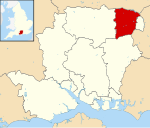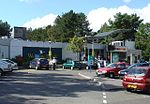All Saints Church, Fleet
1862 establishments in England2010s fires in the United Kingdom2015 disasters in the United Kingdom2015 fires in EuropeChurch of England church buildings in Hampshire ... and 7 more
Churches completed in 1862Fleet, HartGothic Revival architecture in HampshireGothic Revival church buildings in EnglandGrade II* listed churches in HampshireReligious buildings and structures in the United Kingdom destroyed by arsonWilliam Burges church buildings

All Saints' Church is the Anglican parish church of the town of Fleet in the county of Hampshire, England. It is notable for its architect, William Burges and was constructed between 1861 and 1862. A Grade II* listed building, the church was very badly damaged in an arson attack in 2015. An eight-year restoration saw the church reopen in April 2023.
Excerpt from the Wikipedia article All Saints Church, Fleet (License: CC BY-SA 3.0, Authors, Images).All Saints Church, Fleet
Church Road, Hart Fleet
Geographical coordinates (GPS) Address Nearby Places Show on map
Geographical coordinates (GPS)
| Latitude | Longitude |
|---|---|
| N 51.283888888889 ° | E -0.84277777777778 ° |
Address
Church Road
GU51 4NA Hart, Fleet
England, United Kingdom
Open on Google Maps





